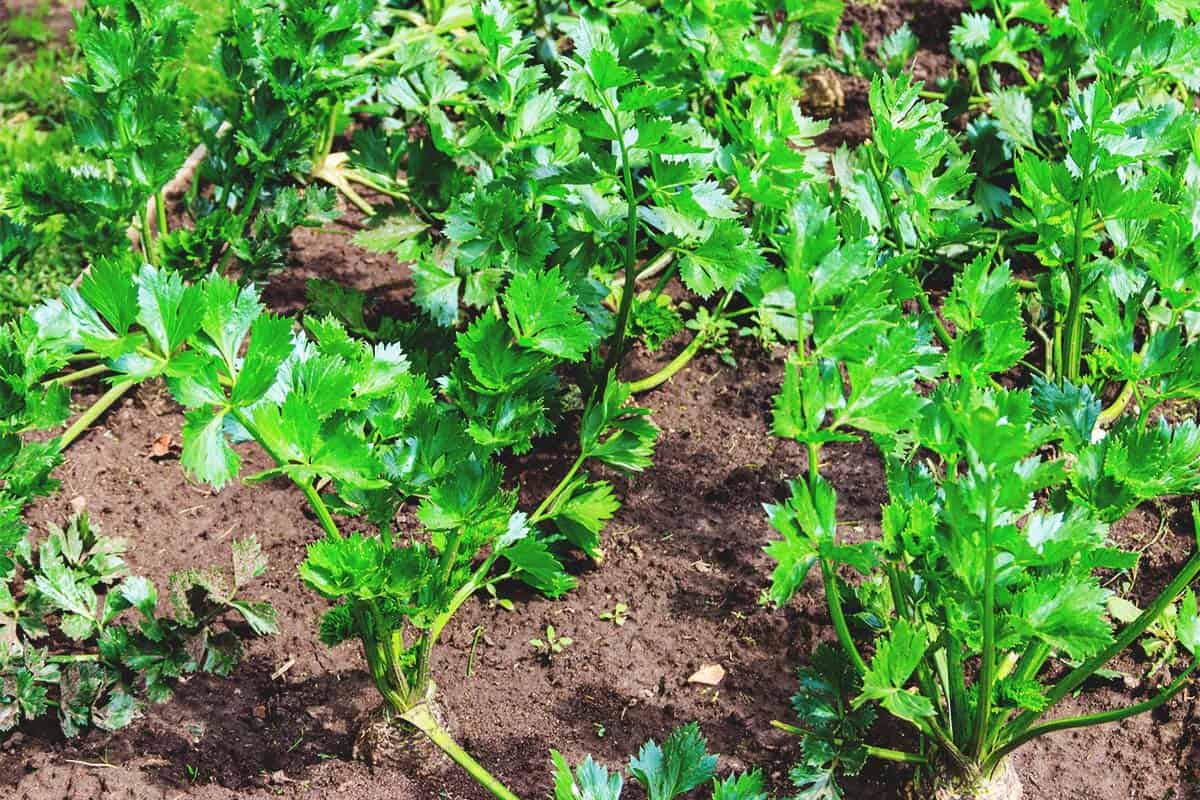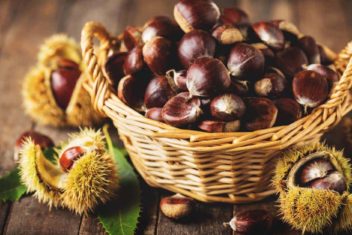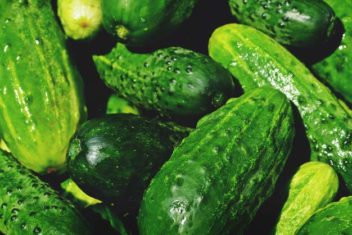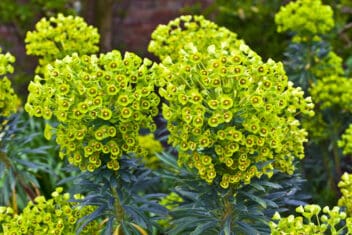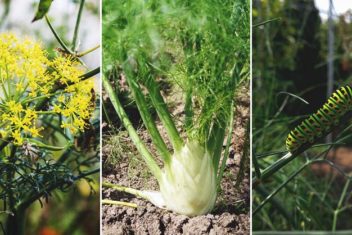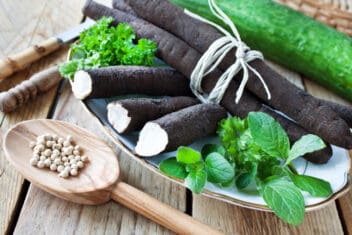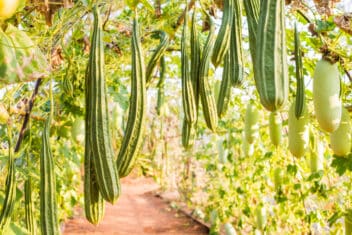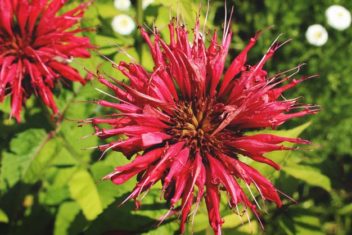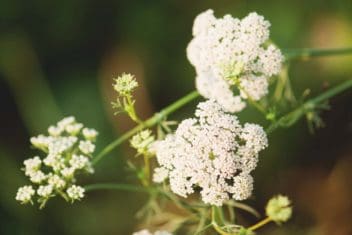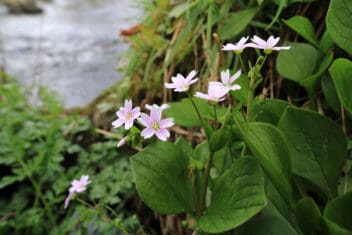Do you enjoy the fresh, crisp taste of celery? I mean, nothing makes a better snack than a piece of celery coated in peanut butter, homemade pimento cheese, or some delicious veggie dip.
Celery offers a ton of health benefits, too. You burn more calories chewing celery than it contains, so it’s considered a negative calorie food. It’s also an anti-inflammatory food source, so it can help fight cancer and chronic disease.
Ready to learn how to grow this tasty treat in your garden?
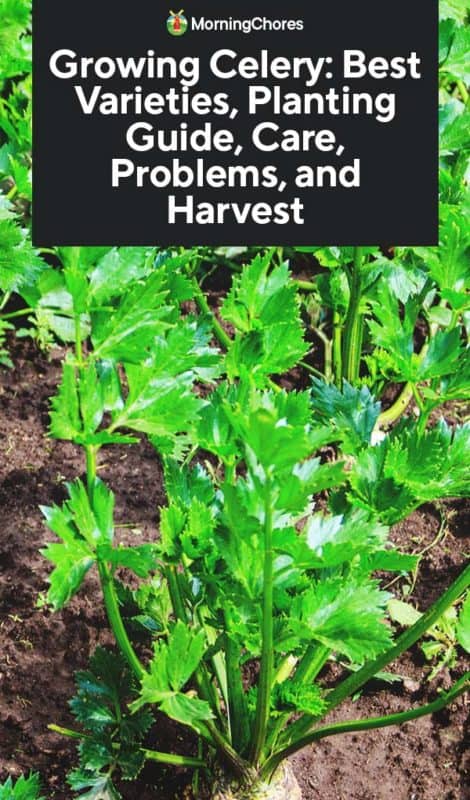
Celery Plant Info
- Hardiness Zones: 2, 3, 4, 5, 6, 7, 8, 9, 10
- Soil: Loam, clay, sandy, fertile, PH between 6.0 to 6.8, thin layer of compost before planting
- Sun Exposure: Full sun, partial shade
- Planting:
- Start Indoors: 10 to 12 weeks before the last frost date
- Start Indoors (in fall): 20 to 26 weeks before the first frost date
- Hardening Off: At least 7 to 10 days before transplanting
- Transplant Outdoors: When the weather has settled after the last frost, when seedlings have 3 to 4 true leaves
- Spacing: 6 to 12 inches between plants and 18 to 40 inches between rows
- Depth: ¼ to ½ inch seed depth
- Best Companions: Beans, onions, cabbage, leek, cauliflower, spinach, tomato, cucumber, garlic, lettuce
- Worst Companions: Corn, carrots, irish potato, parsley, parsnip
- Watering: Heavy, at least 1 inch per week
- Fertilizing: Apply balanced fertilizer 2 to 3 weeks before planting, side-dress after every 10 to 14 days
- Common Problems: Bacterial blight, soft rot, celery mosaic, dumpin off, early blight, downy mildew, late blight, fusarium yellows, powdery mildew, pink rot, armyworm, aphids, nematodes
- Harvest: 100 to 130 days after seed starting, when the stalks are at least 8 inches long
Best Celery Varieties
There are three main types of celery: Celeriac is grown for its tasty root, which is great for mashes and purees. Leaf celery is grown for its fragrant foliage. Stalk celery is the most common type of celery grown specifically for its crisp, crunchy stalks.
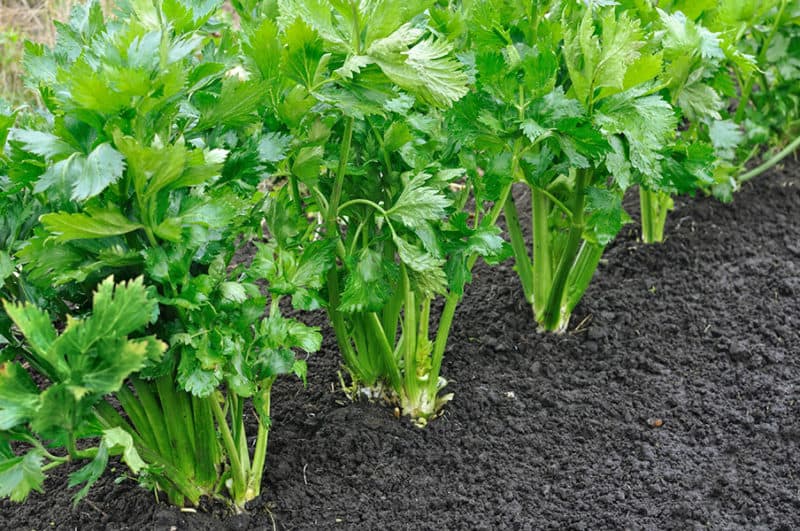
We’ll focus on leaf and stalk celery in this article. You can check out our growing guide especially for celeriac if you want to learn more about that type.
Here are some varieties of leaf and stalk celery you might consider growing in your garden:
Golden Self-Blanching Celery
This variety doesn’t require the grower to manually hill around the base of the plant to blanch the stalks. It’s an heirloom variety with thick stems.
Cutting Celery
Bred for its foliage rather than its stalks, this type is easy to grow and the leaves are full of flavor.
Red Celery
This is a unique variety with reddish stems and dark green leaves. It’s also an heirloom varietal with an exceptional flavor profile.
White Plume Celery
Grown more for its foliage than its stalks, this thin-stalked celery is a smaller variety with crisp stems and fragrant leaves.
Tango Celery
This is a flavorful stalk celery that handles drought a little better than other varieties.
Conquistador Celery
This variety produces very nice, upright head of celery with crisp stalks that are rarely hollow. Conquistador adapts well to heat and low-moisture conditions.
How to Plant Celery
Celery is known as being a difficult plant to grow. Don’t let that discourage you. It’s totally possible.
Sun Requirements
Plant your celery in a sunny spot. It can handle a bit of shade, but for ideal growth, it should be in full sun.
Celery grows in USDA zones 2-10.
Soil Requirements
Celery plants prefer loamy, sandy, and clay soils. Soil should be fertile with a pH between 6.0 to 6.8. Add a thin layer of compost before planting or transplanting.
When to Start
Start celery plants indoors between 10 and 12 weeks before your area’s last frost date. For fall planting, starts celery indoors between 20 to 26 weeks before the last frost date. Harden off plants between 7 to 10 days before transplanting.
If you decide to direct sow your seeds, do it when temperatures are between 55°F and 70°F. Celery will wilt if planted when it’s hotter, and it won’t produce if the temperatures are any lower.
This is why in colder regions, celery is grown during the summer. In warmer regions, it’s a late fall or winter crop.
Growing Celery From Scraps
I love the idea of growing celery indoors. I think it is neat to have your vegetables readily available and growing fresh right on your counter or windowsill.
To start, purchase a bunch of celery from your local supermarket or farmer’s market. Cut off the base of the celery. Wash and store the celery stalks as usual and use them at your convenience.
Save the base because this is your new celery plant. Here are the steps to making it sprout:
1. Soak the Base
Fill a small bowl with warm water. The warm water helps germination take place.
Place the base of the celery in the warm water and leave it for one week near a window or other light source. Be sure that the cut side of the base is facing up in the bowl.
Change the water every few days.
2. Transplant the Base
After one week has passed, you should begin to see tiny sprouts of new growth. This is when you’ll know that the base is ready to be transplanted.
Remove the base of the celery from the bowl of water. Then, fill a flower pot with potting soil. Place the celery base in it, and cover it completely with soil. Only the sprouts should be left sticking up out of the potting soil.
Water your plant using a spray bottle. That way you won’t overwater the plant. You want it to be moist and remain moist without drowning it.
Growing Celery from Seed
Press seeds into the soil and don’t cover them. Keep seeds moist, both by watering the soil and by spritzing seedlings with water. If they dry out, the seeds will die.
Spacing
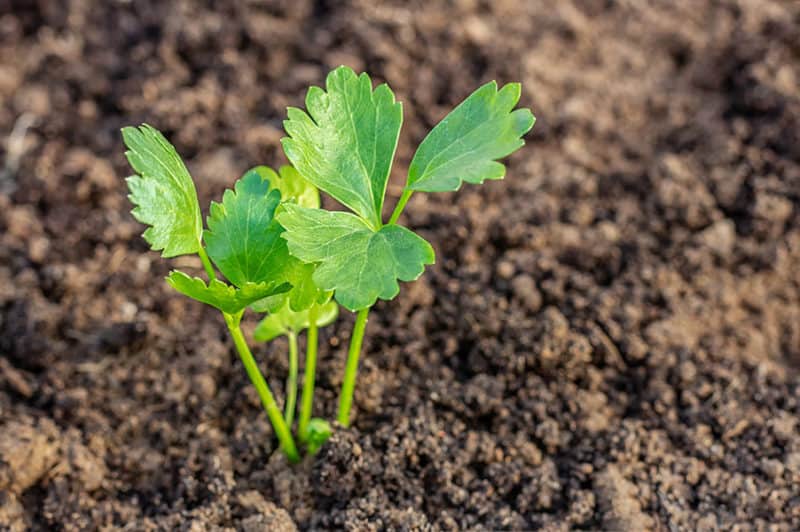
When planting your seedlings, make sure they are planted 10-12 inches apart.
If you are sowing the seeds directly into the soil, plant them a quarter of an inch deep, and then you’ll need to return to thin them out after germination has occurred.
You want to thin them to 12-inches apart after they have reached 6 inches or greater in height.
Caring for Celery
Growing celery is rather finicky. It doesn’t like heat and it needs constant moisture. It has a long growing season and needs lots of fertilizer.
Give it all that and it will grow happily.
Mulch Your Plants
Celery loves moisture. It needs to be mulched well in order to prevent the water from evaporating.
Mulch around each plant with an inch of material.
Watering
Be sure to water the celery regularly throughout the entire growing period. If your stalks are looking small and dry, then you know they aren’t being watered enough.
Tie the Stalks
After you have the food and water part covered, you’ll need to remember to tie the stalks together.
When your celery begins to take off, instead of letting the stalks lay everywhere, tie them together neatly with twine. This keeps them from crawling all over the ground.
Problems and Solutions to Growing Celery
Celery has several pests and diseases that you need to watch out for:
Cutworms
Cutworms nibble at the base of plants and kill them. Check out our guide for how to identify and destroy them.
Whiteflies

These tiny pests can wreak a lot of havoc. Here’s everything you need to know to spot and control them.
Aphids
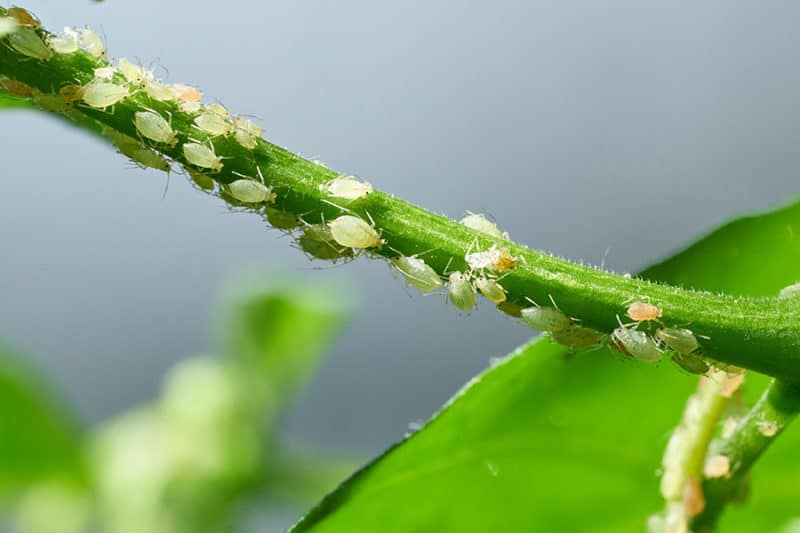
Aphids suck the life out of a number of different plants. Want to get rid of them? Check out our guide.
Root Knot Nematodes
Root knot nematodes can stunt the growth of celery plants. Plant resistant varieties if you know this pest is in your area.
Rotate crops and be sure to sanitize your tools in between use.
Mosaic Virus
This virus causes a mottled pattern to form on the leaves of plants. It’s spread by aphids, so be sure to keep them away from your plants by weeding often and spraying with insecticides if necessary.
Once your plants have it, there’s no cure.
Damping Off
Damping off impacts young seedlings of growing celery plants in particular. This article will help you deal with and avoid the problem.
Downy Mildew
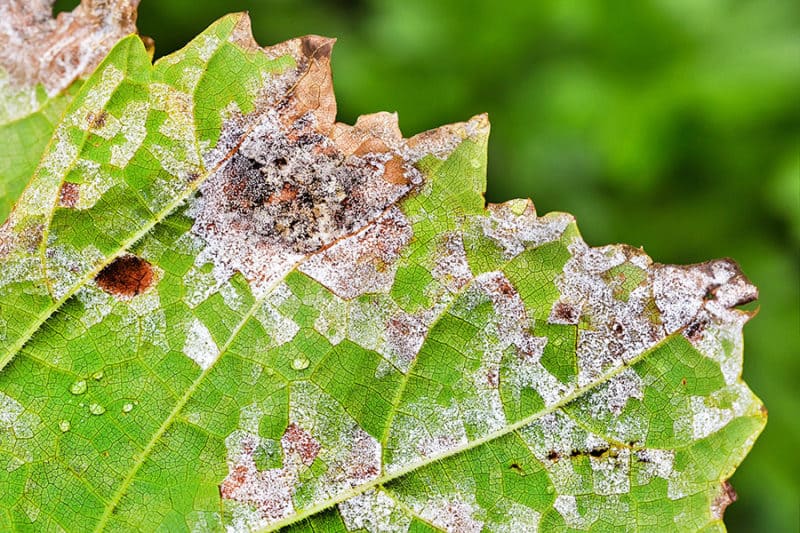
It’s easy to spot downy mildew: it looks like someone came and dusted your plants with powder. Here’s how to handle it.
Bacterial Blight
This bacteria causes water-soaked spots to form on the leaves of plants. It prefers warm, humid conditions.
Avoid over-fertilizing and spray with copper fungicides if you spot this disease.
Best Companion Plants for Celery
Are you wondering what to plant next to your celery? Here are the best companion plants for this vegetable:
- Beans
- Onions
- Cabbage
- Leek
- Cauliflower
- Spinach
- Tomato
- Cucumber
- Garlic
- Lettuce
Don’t plant celery near:
- Corn
- Carrots
- Irish Potatoes
- Parsley
- Parsnip
Harvesting and Storing Celery
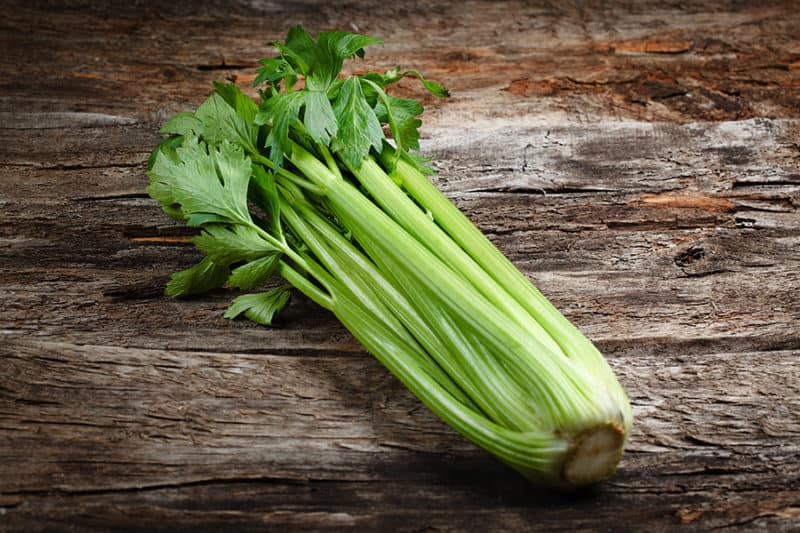
Celery takes a long time to mature—harvesting usually happens between 100 to 130 days after starting seeds. When stalks reach 8-inches in height, they’re likely ready to harvest, but this may depend on the variety.
Celery is harvested at the stalks, leaving the root in place. Cut the stalks from the outside and work your way in. The greener you allow the stalks to become the more nutrients they’ll have.
After you harvest the stalks of celery, place them in a plastic bag and keep them in the fridge for no more than two weeks. You can also freeze celery.
Recipes to Use Your Celery
If you love celery, you might be ecstatic to learn how to grow it. But if you are someone that likes to grow as much of their own food as possible, but just can’t see yourself utilizing all of this celery, then you might need a few recipes to point you in the right direction.
1. Braised Celery
This recipe shows you how to use celery as a delicious side dish. It requires only a few basic ingredients and would accompany most meat dishes well.
If you’re looking for all of the healthy vitamins and minerals that celery can provide in a different way, then you’ll want to give this recipe a try.
Here’s how to make this celery dish.
2. Cream of Celery Soup
This is another super simple recipe. You can eat it alone or use it as a base to some cream soups. Or you could use it with crockpot chicken recipes to give it a different taste.
3. Green Apple, Celery, and Walnut Salad
Do you like crispy salads? If so, then you will probably love this recipe. It has a ton of fresh ingredients that all offer a lot of crunch.
4. Buffalo Chicken and Celery Appetizer
I really like this celery recipe. The reason is that I love celery with all kinds of different items on it. Since I’m a huge buffalo chicken fan, this would naturally be a great topping for me.
So if you like to enjoy celery with yummy goodness heaped on top of it, then you’ll want to check out this recipe.
Every Garden Should Have Celery In It
Celery can be a challenge, but it’s worth it. Once you figure out how to make it work in your garden, you’ll have a tasty harvest that beats anything you find in the store.
I’d love to hear what you think. Have you ever grown celery? What challenges did you face? Was it easy or hard for you? And how did you utilize or preserve your harvest?
